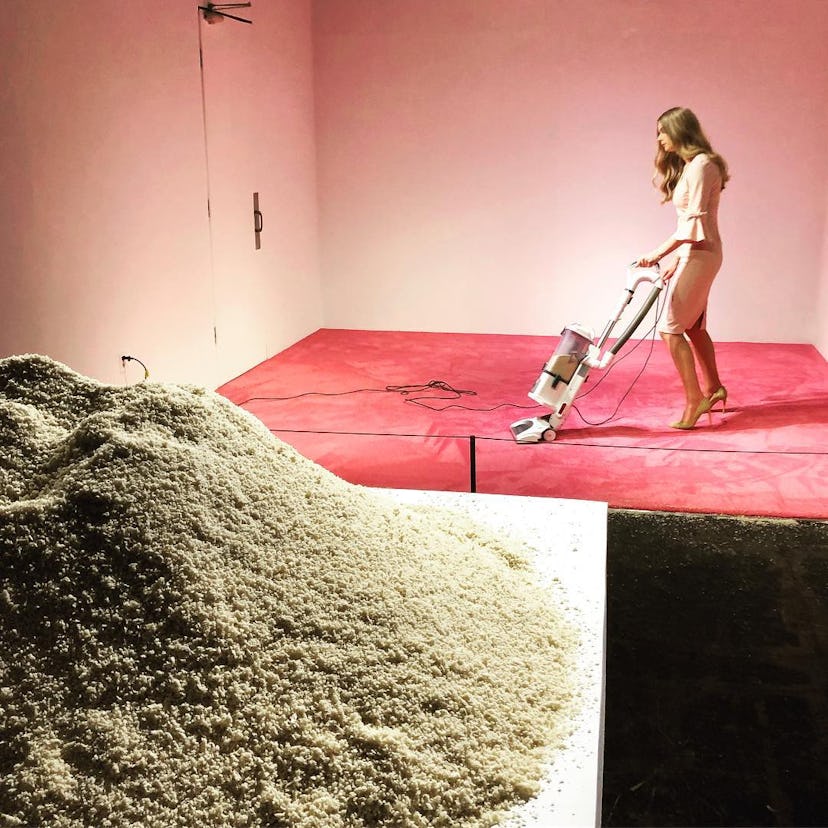Is Ivanka Trump Vacuuming Performance Art? Does It Matter?

“Women can choose to knock each other down or build each other up. I choose the latter,” Ivanka Trump tweeted earlier this week to her 6.17 million followers. She was commenting on a story about the artist Jennifer Rubell‘s latest work, titled Ivanka Vacuuming,” at the Flashpoint Gallery in Washington, D.C., where visitors are invited to throw crumbs at an Ivanka look-alike performer who’s cordoned off in a separate, pink-carpeted area as she repeatedly vacuums—in heels, no less—every night for two live-streamed hours. (The show goes through February 17.)
Needless to say, the reactions have been mixed. Ivanka’s public stance is that Rubell is simply knocking other women down—a tweet that’s since gotten more than 19,000 replies, not all of which have been in agreement. There are those who take it at face value, delighting in its apparently simple act of trolling; there are those so disgusted with Rubell that they’ve taken to publicly tearing her down; and there are those who simply don’t consider the work to be art. The latter is just fine with Rubell, who’s standing by her view that art can offer a truth that politics can’t: “Historically, most work that’s received that way ends up being considered some of the most important art of our time. So I’m taking that as a massive compliment,” she explained over email.
Of course, Ivanka Vacuuming isn’t just about doing a household task; as Rubell points out, it’s a stereotypically feminine one, which could be interpreted as standing for Trump cleaning up the mess of her father’s administration or simply standing by, say, her father’s “zero tolerance” immigration policy, which has separated thousands of migrant children from their parents. In that’s sense, it’s complicity that’s the focus of the work, which doesn’t only apply to Trump but also the gallery visitors themselves. Hear it from Rubell herself, here.
How and when did the idea for “Ivanka Vacuuming” come to you?
It all started when I saw footage of Ivanka at the G20 summit wearing that pink dress with the bow sleeves. I was struck by what a feminine wardrobe decision she made in a context where most women would use their clothing to play up their seriousness. I wasn’t judging it—it was just such an unusual choice. It piqued my interest, and my piece evolved out of that.
Ivanka Trump at the G20 summit in Hamburg, Germany, wearing the dress that inspired Jennifer Rubell, July 2017.
Why vacuuming?
The vacuuming was almost like accessorizing the outfit, complementing it with a traditionally feminine-gendered activity. And then I wanted viewers to be staked in that activity by creating the reason Ivanka was vacuuming in the first place, so that’s where the crumbs came in. It was important to me that the viewer and the Ivanka figure together took responsibility for what she was doing.
How did you go about finding the look-alikes?
I shared the photo of Ivanka from the summit with a modeling agency. It was as simple as that. But then it required quite a lot of hair and makeup expertise to even come close to Ivanka’s look. It’s funny—traditional art education used to have artists go to museums and try to copy Old Master paintings. They’d learn so much just by trying to imitate them. I learned so much about what we’re really looking at when we’re looking at Ivanka Trump from the experience of trying to replicate her.
An Ivanka Trump look-alike featured in “Ivanka Vacuuming,” a participatory performance by Jennifer Rubell at Flashpoint Gallery in Washington, D.C.
An Ivanka Trump look-alike featured in “Ivanka Vacuuming,” a participatory performance by Jennifer Rubell at Flashpoint Gallery in Washington, D.C.
Do most of the visitors end up throwing the crumbs?
Almost everyone who comes into the gallery. People have a wide range of emotions around doing it: glee, embarrassment, disappointment, joy. It runs the whole gamut. The tone in the space is very serious, very solemn, almost meditative. People have the opportunity to think about what they’ve done, what other people are doing, what Ivanka is doing. And then they can reach their own conclusions. Every person’s experience is different, and every person’s interpretation of the work is different.
What was your reaction when Ivanka responded?
I had invited her to come see the piece in person and she never responded, so I was surprised that she tweeted about it without having seen it. In person, the piece is a lot more complex and nuanced than the descriptions—particularly the very partisan ones—of it have been.
What did you think of her response?
Well, I’m definitely not knocking her down or building her up. That kind of zero-sum view of the world is how politics works, but it’s not how art works. The piece is really a portrait of our time, not a judgment of our time. And the reaction to the piece is a portrait of our time too.
What do you think of the criticism, including from Trump’s brother, that the piece is sexist?
What’s sexist? Having a powerful woman perform a domestic chore? Dressing that woman in an outfit made by a company that she created, an outfit that she wore to represent her country? Throwing crumbs on a carpet for that woman to vacuum? Watching this whole thing unfold? Calling me—the artist—ugly and jealous? The tricky part of this piece is that everyone is implicated: me, the viewer, Ivanka, the person tweeting from their living room in Nebraska. No one is let off the hook. It’s uncomfortable for all of us.
Related: Ivanka Trump Is So Not Worried About Any of Her Family Members Going to Jail
An Ivanka Trump look-alike featured in “Ivanka Vacuuming,” a participatory performance by Jennifer Rubell at Flashpoint Gallery in Washington, D.C.